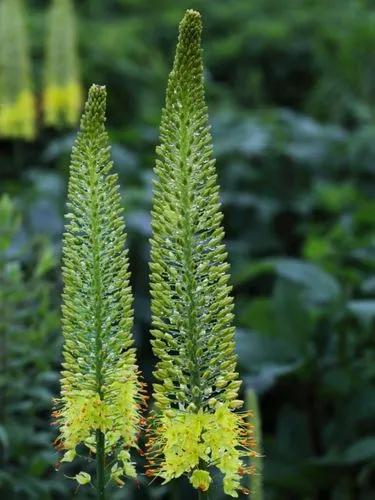Opuntia ficus-indica is polyploid, hermaphrodite and autogamous. As Opuntia species grow in semi-arid environments, the main limiting factor in their environment is water. They have developed a number of adaptations to dry conditions, notably succulence. The perennial shrub Opuntia ficus-indica can grow up to 3–5 m height, with thick, succulent and oblong to spatulate stems called cladodes. It has a water-repellent and sun-reflecting waxy epidermis. Cladodes that are 1–2 years old produce flowers, the fruit's colours ranging from pale green to deep red. The plants flower in three distinct colours: white, yellow, and red. The flowers first appear in early May through the early summer in the Northern Hemisphere, and the fruits ripen from August through October. The fruits are typically eaten, minus the thick outer skin, after chilling in a refrigerator for a few hours. They have a taste similar to sweet watermelon. The bright red/purple or white/yellowish flesh contains many tiny hard seeds that are usually swallowed, but should be avoided by those who have problems digesting seeds.
Opuntia Maxima Care
Opuntia Maxima



How to Care for the Plant

Water

As to be expected, the prickly pear cactus is extremely drought tolerant, so when it doubt, water it less than you think it needs. In most areas, your typical rainfall will likely be enough for the cactus to thrive but if not, you can plan to water the plant every two to four weeks.

Fertilizer

When planted outdoors in garden soil, no fertilizer is needed. However, occasional feeding may be required indoors. Use a well-balanced fertilizer and let the plant tell you when it needs food.

Sunlight

As with most cacti, the eastern prickly pear does best in full sun for at least eight hours a day.

Soil

In order for the prickly pear to thrive, it needs to be planted in well-draining soil. Your best bet is a mixture that is dry, sandy, or gravelly, but it can also do well in a mixture that is primarily clay, so long as it drains very well and the soil does not retain much moisture.

Temperature

Like any cactus, the prickly pear likes warm, dry weather. Though it's more cold-hearty than most other cacti and can survive cold temperatures down to 14 degrees Fahrenheit, it will grow larger.

Popularity

209 people already have this plant 35 people have added this plant to their wishlists
Discover more plants with the list below
Popular articles






